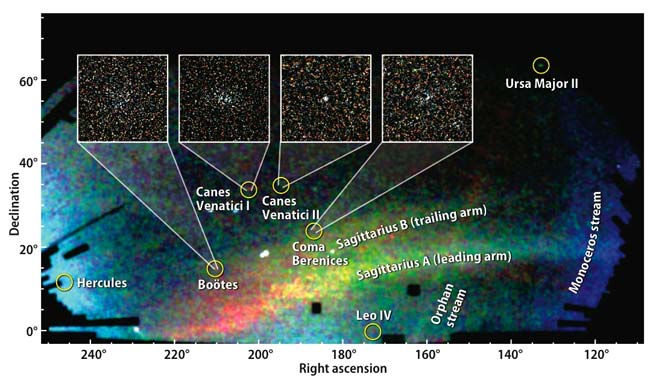
Small, ultrafaint "hobbit" galaxies recently found hovering around our Milky Way are comprised almost entirely of dark matter, a new study confirms.
Dark matter is a mysterious substance scientists think accounts for most of the mass in the universe but that is invisible to current instruments.
The finding, to be detailed in the Nov. 10 issue of Astrophysical Journal, could help resolve a cosmic accounting problem that has long vexed astronomers and also explain how such small galaxies form.
Missing Dwarf Galaxies
According to the "Cold Dark Matter" model, which explains the growth and evolution of the universe, large galaxies such as our Milky Way should be surrounded by a swarm of up to several hundred smaller "dwarf" galaxies. However, until recently, only 11 such companion galaxies have been found.
To explain this so-called Missing Dwarf Galaxy problem, theorists have suggested that the majority of dwarf galaxies contain very few, if any, stars and are instead made up mostly of dark matter.
Earlier this year, members of the Sloan Digital Sky Survey team announced they had discovered eight small and extremely faint galaxies in our Local Group of galaxies that might belong to this bizarre class of "dark" galaxies.
Get the Space.com Newsletter
Breaking space news, the latest updates on rocket launches, skywatching events and more!
Because the new satellites were far smaller than known dwarf galaxies such as the Large and Small Magellanic Clouds, some of the scientists dubbed them "hobbit" galaxies.
Using the Keck II telescope in Hawaii, Joshua Simon of Caltech and Marla Geha of the Herzberg Institute of Astrophysics in Canada conducted follow-up studies to calculate the mass of the hobbit galaxies based on the speeds at which stars inside them moved. The pair confirmed that each galaxy was among the smallest ever measured, more than 10,000 times smaller than the Milky Way.
They also found that the mass of the galaxies was about 100 times more than what would be expected from the mass of their stars alone. "And so the rest of it has to be in some other kind of matter," Simon told SPACE.com.
Most galaxies, including our own, are thought to have more dark matter in them than normal matter, but the new hobbit galaxies take this trend to an extreme.
"Our work narrows the gap between the Cold Dark Matter theory and observations by significantly increasing the number of Milky Way dwarf galaxies and telling us more about the properties of these galaxies," Simon said.
Taft Armandroff, director of the W.M. Keck Observatory, called the new findings "significant."
"This is the first real step towards solving [the Missing Dwarf Galaxy problem]," said Taft, who was not involved in the study.
The new findings also offer a possible explanation for how such small galaxies form. Based on the mass measurements for the hobbit galaxies, the researchers speculate that fierce ultraviolet radiation given off by the first stars, which formed just a few hundred years after the Big Bang, might have blown all of the hydrogen gas out of the still-forming hobbit galaxies.
The loss of gas would have severely stifled future star formation, leaving the galaxies very faint or completely dark.
Flushing them out
Simon estimates that scientists will need to find another 100 to 200 such galaxies to finally resolve the discrepancy between the number of predicted and observed dwarf galaxies.
This could prove difficult, however, since scientists predict that many dark matter galaxies do not contain any stars at all. One possible way to flush these invisible galaxies out might be to look for effects they have on our own galaxy.
"If you have hundreds of these things orbiting the Milky Way, you might expect them to have an effect on the disk of our galaxy," Simon said. "The Milky Way has a very thin disk of stars and gas that goes out tens of thousands of light years. If it's continually getting pummeled by these clumps of dark matter, each weighing a million solar masses, then you might expect that to affect the structure of the disk."
Alternatively, some scientists speculate that dark matter particles can act like their own antimatter particles. When normal matter and antimatter collide, they annihilate each other and create a lot of energy.
"Dark matter might do the same thing," Simon said. "You would see this as very high-energy gamma rays coming from these clumps of dark matter."
Future space observatories, like NASA's GLAST telescope slated for launch next year, could detect these dark matter gamma rays, Simon said.
- The Top 10 Strangest Things in Space
- Astronomers Find Thousands of New Galaxies
- Tiny Galaxies Hide Dark Secret
Join our Space Forums to keep talking space on the latest missions, night sky and more! And if you have a news tip, correction or comment, let us know at: community@space.com.
Ker Than is a science writer and children's book author who joined Space.com as a Staff Writer from 2005 to 2007. Ker covered astronomy and human spaceflight while at Space.com, including space shuttle launches, and has authored three science books for kids about earthquakes, stars and black holes. Ker's work has also appeared in National Geographic, Nature News, New Scientist and Sky & Telescope, among others. He earned a bachelor's degree in biology from UC Irvine and a master's degree in science journalism from New York University. Ker is currently the Director of Science Communications at Stanford University.












